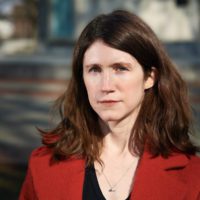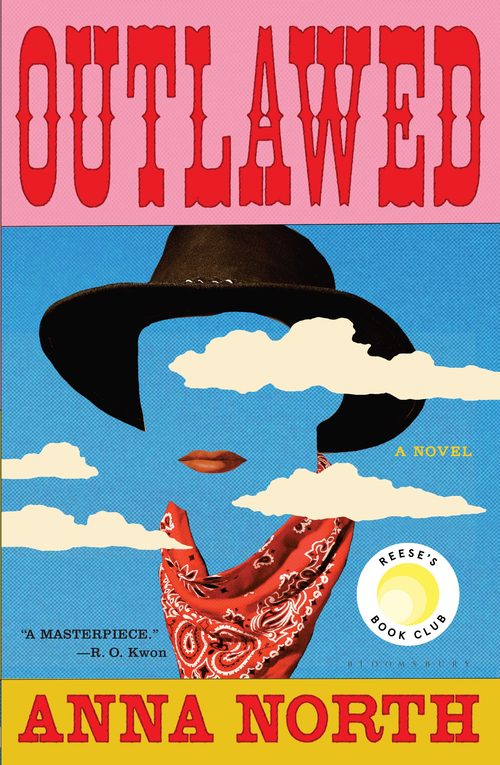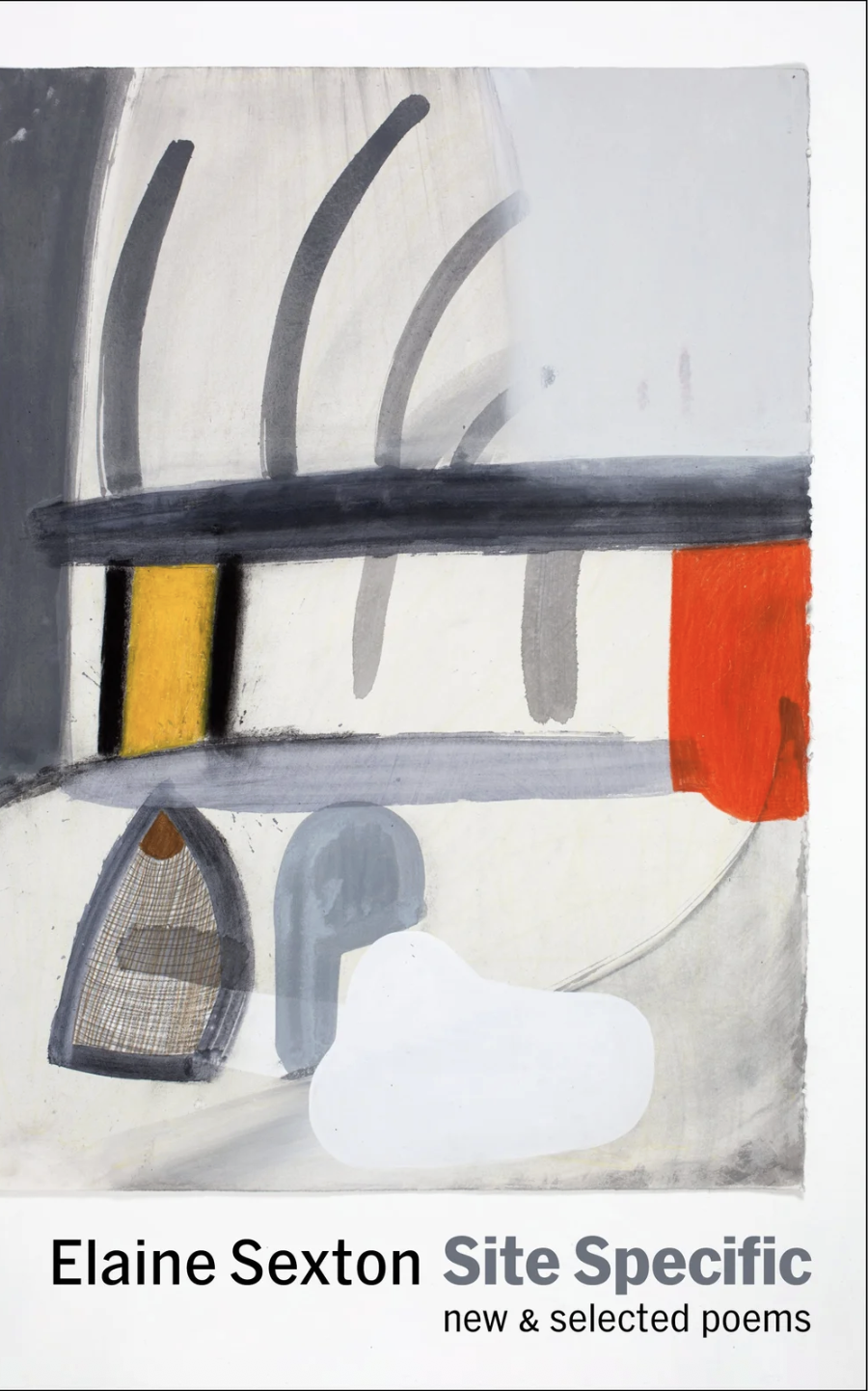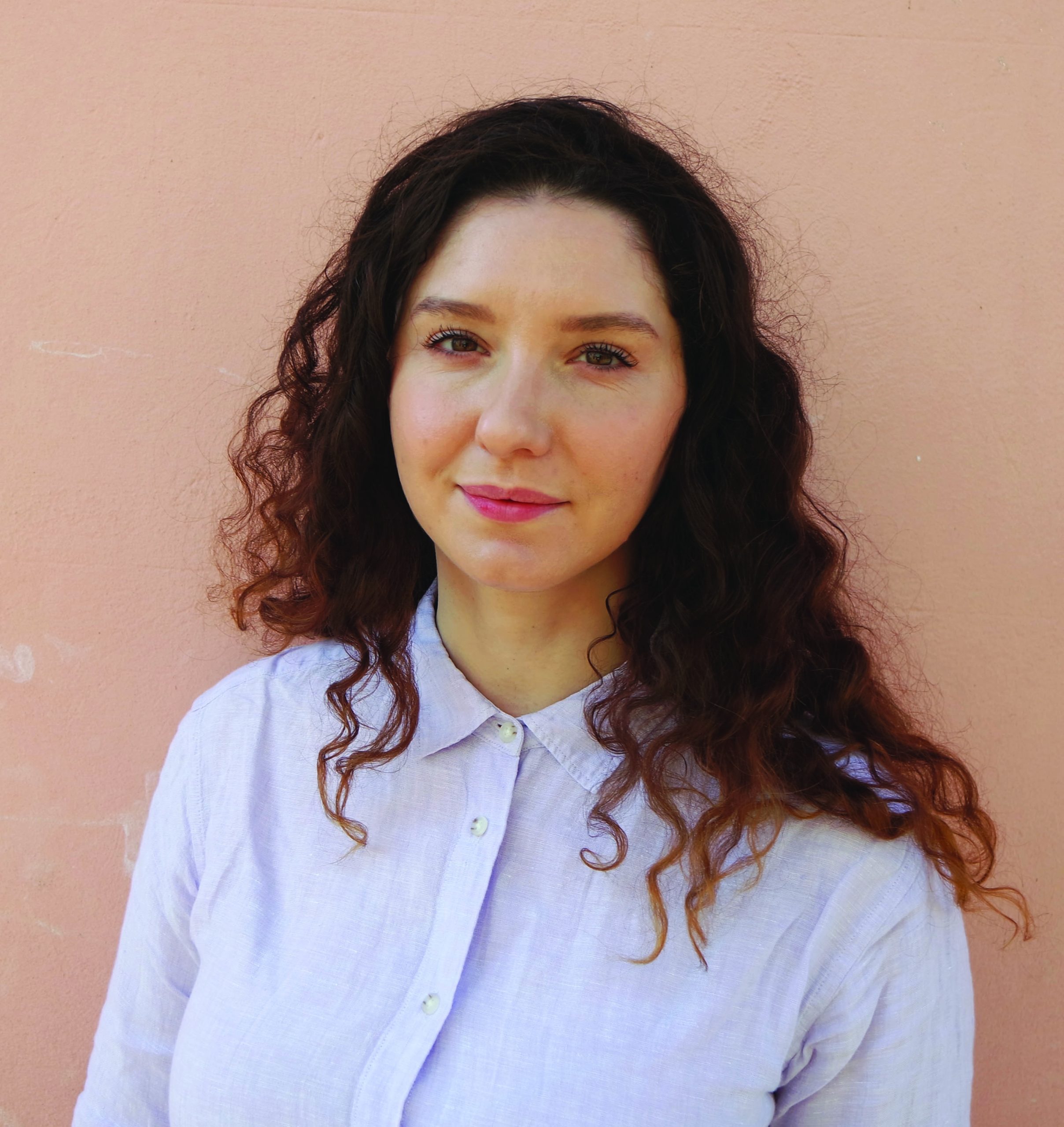“In the year of our Lord 1894, I became an outlaw. Like a lot of things, it didn’t happen all at once.” So begins Outlawed, Anna North’s latest novel. Set in an alternative Old West, the novel follows Ada, a young and precocious midwife. She marries at seventeen, but when she fails to become pregnant, the strict fertility laws that govern her society herald her as a witch. After a brief tenure as a nun, she joins a band of gender nonconforming outlaws known as the Hole in the Wall Gang, led by a nonbinary outlaw styled as “the Kid.” As she adjusts to her role as an outlaw, she finds herself propelled by a self-imposed mission to understand the science behind infertility.
Outlawed has been praised for its subversiveness, bending familiar tropes around gender, the West, and familial structures. Hailed for its feminist canvas, North has written a Wild West where the rules of society heavily regulate women’s bodies—and shame the enigmatic runaways who try to build better and more inclusive lives.
Currently a senior reporter at Vox, North has previously written for the New York Times, Salon, BuzzFeed, and Jezebel. She holds an MFA from the Iowa Writers’ Workshop and is the author of America Pacifica and The Life and Death of Sophie Stark.
I spoke with North over a Zoom call in late March, where we discussed our culture’s pervasive fixation on women and sexuality, the duality of faith and science, the history of outlaws, and more.
***
The Rumpus: First, this novel encapsulates everything I love in a single text. We have feminist outlaws, the impact of found family, witchcraft, and the undoing of strict gender roles surrounding women and fertility. I want to speak more about Ada, though, because she endures conflict beyond her years. She’s a teenager but bears the emotional intelligence of a much older protagonist. And, in turn, her naiveté is very much of her age. Her flaws directly impact the people relying on her for their own survival. How do you begin to draft a character like Ada? How did she come into focus?
Anna North: Ada is someone who has worked from such a young age. She’s an apprentice to her mother, and she’s attended births since she was a young teenager, and that’s very intense. You see a lot of joy, but you see a lot of trauma. We also see that she’s had to step into a parenting role for a time with her own sister while her mother struggled with postpartum depression. She’s had a lot of experiences that have given her a certain degree of wisdom.
It was important to me, though, to not depict her as too wise, or too perfect as a character. I wanted to show the limits of some aspects of her worldview. I think she’s someone who really believes—especially at the beginning of the book—that if people just had the right knowledge, they wouldn’t do bad things, or they wouldn’t stigmatize other people. She believes the stigma that she experiences as someone who is infertile could be cured if everyone had the knowledge that she did.
I think we see, in the modern context, that that’s not always true. As a white writer, one of the most difficult aspects for me of writing this book was writing the sections that deal with eugenics and racism. Ada is white, and I did want to give readers some sense of her naiveté in this world where racism plays an integral role. This is not a form of oppression that she understands well, and this might not be a form of oppression that she particularly understands how to combat. Despite her wisdom and her intellect, there’s a lot of ways in which she really has a lot to learn.
Rumpus: In Outlawed, women are valued for their bodies and for their fertility. The inability to birth children is punishable by death. Although the story takes place in a reimagined Wild West governed by unnerving fertility laws, the attentiveness to a woman’s womb will always feel timely, because women and their wombs are still public discourse.
North: This novel serves as an alternative history—it’s set in an alternative version of 1894, and it’s not our world. At the same time, none of this is particularly outlandish. We might not see the exact laws or the exact mores that are depicted in the book, but we’ve certainly seen women throughout history be persecuted for infertility, or for excessive fertility, or for fertility that’s outside the norm. We see this with American social policy today. There is so much fixation centered on who should reproduce, and how they should reproduce. What is the appropriate way to have a family, and what is the appropriate time? I think we constantly see these questions gendered and racialized in the United States.
The witchcraft narrative you noted is an interesting theme, too. There are some interpretations that argue that witch trials were a means of punishing a woman around forbidden sexuality. We’ve even seen midwives being persecuted as witches in Europe. There are all sorts of beliefs and stereotypes around women’s “problematic” sexuality, or women’s problematic fertility, and it’s often linked to witchcraft.
Rumpus: You so skillfully balance a rich plot with engaging prose. Through Ada, I can see the blood pooling through an open wound, hear the flare of gunfire, feel the unease of a hand that hardens into a fist. What’s more thrilling for you: robbing a bank, or detailing the surge of adrenaline that comes with the defining action?
North: The crimes that the gang ends up committing were fun for me, because I started writing this book with no notion of how an outlaw in the 1890s would commit a crime. What did a bank robbery entail in 1894? I actually watched a lot of heist movies. I didn’t want to watch a lot of Westerns because I didn’t want to bias myself, but I wanted some inspiration. Heist movies are great, and they contain a very similar energy to this book. You have a team, and everybody on the team has their own skill set, and you have to bring the team together. There’s usually one big score. There’s going to be a vulnerability in the bank or the museum where you’re going to steal the diamond, and that’s what enables the team to get in, and then there’s the twist where it doesn’t work.
In terms of blocking and structure, those films were really helpful. There’s been more female-driven heist movies in recent years, so that was fun, too. The other aspect here is that I wanted the language of the body and what happens to the body to take up as much space as the gunplay. That’s why the births are depicted very frankly; surgeries are depicted frankly; people who have had trauma to their bodies are shown healing from that trauma. I tried to depict it honestly. If there’s blood in the book, it’s not just the blood around a battle. There is blood around childbirth. I wanted to tell a more embodied story, and to remind people that there are a lot of ways that people can be tested physically. I think a lot about this line from Brit Bennett’s first novel, The Mothers: “Men think anything difficult is war.” I wanted to point out that not everything difficult is war, and that there are difficult things that happen to people’s bodies that don’t have to include a gunfight.
Rumpus: The Hole in the Wall Gang feels less like a band of outlaws and more like a string of neglected souls desperate for connection. Ostracized for their bareness, these people find love and intimacy and loyalty in their makeshift home. I was hoping we could delve into the contextual history of a band of outlaws, and how you implemented emotional resonance there.
North: I did spend some time researching the history of outlaws, but I also retaught myself American history. It’s been a long time since I was in high school, and there’s a lot of histories I didn’t learn. So, that included reading histories of Black Americans in the West, and reading histories of Indigenous people in what white Americans called the American West, but what obviously wasn’t the West to them. I was trying to learn various histories that had been marginalized. I did go into looking at the real-life Hole in the Wall Gang to a degree, who were a real outlaw gang. They were sort of a loosely knit group of people. They had a hide out at Hole-in-the-Wall in Wyoming, which I visited as part of my research. Delving into the gang was really interesting, because it did include people of different backgrounds, including women. I don’t know to what extent the Hole in the Wall Gang was multiethnic, but of course there were Black and Latinx and Indigenous outlaws, just as there were Black and Latinx and Indigenous cowboys. These regions have always been racially diverse in a way that the movies haven’t really portrayed.
I also wanted to portray the reasons why folks became outlaws. Butch Cassidy and the Sundance Kid and other famous outlaws of the American West became criminals for a variety of reasons. In the case of the novel, the folks who join the gang ultimately don’t have a lot of other options. I liked Outlawed as a title because it gestures to the fact that this life was imposed upon them to a degree, and these are people who are outlawed from society. This is the way that they survive. I tried to gesture to the moral quandaries of that life, too, which included killing people. It is at this point in their alternate history a means of carving out a way of life. When I started writing, I was really conscious of not wanting to write another dystopia. As the world starts to get more and more dystopian, my appetite for dystopia is less and less. Our sense of whether the world is getting better or worse is always dependent on our position within it. There are elements in the book that I think can feel utopian, and I think the members of the gang and their relationships to one another are one of those elements. It’s not utopian to have to become an outlaw, but the society that they create is one of mutual respect. They make decisions collectively, and they are really mutually supportive. They share resources with one another. Most of the societies depicted in the book are deeply repressive, but here’s a gang motivated by a deeper sense of hope.
Rumpus: You take so many familiar tropes and subvert them. The members of the Hole in the Wall Gang are gender nonconforming, and Ada is forced to reckon with everything she was taught about gender, sexuality, and the intentionality of marriage. The body you are born into is not the body you must inhabit. There are so many layers to people, and there are so many ways to live.
North: I think one challenge was initiating Ada into the gang, and indoctrinating the process of her learnings surrounding sexuality and gender as it exists in her world. I wanted to show her being naive, but I didn’t want her to be a bigoted character. It’s complicated trying to identify how to interject someone who’s very young, and has only existed within a very small, repressive community into this place where people are living in openly gay relationships. She doesn’t come to the gang with the notion that it could be legitimate to have a real or long-term relationship with someone of the same gender. She has this notion that someone could live this life for a short period of time, but ultimately, you’re going to get married and have children. The portion of the novel where she starts to see that subverted was difficult for me to write. It was a delicate balance between wanting her to have her eyes opened, but not wanting to seem preachy.
I also just had a lot of fun with the gang, and thinking along the lines of subverting some of the tropes that you were talking about: the cowboy movie tropes; the outlaw tropes, and the really hyper-masculine cowboys we’ve become accustomed to. Those tropes have already been subverted, because you have a long tradition of gay cowboys. We obviously have Brokeback Mountain, but it extends well before that. Cowboys out on the range have always been one of these groups of men that are almost exclusively with other men, which can lead to a lot of really interesting queer readings. A lot of the material was already there, and it was just a matter of bringing it out, or playing with it. When Ada first encounters the gang, I wanted to think about what was going to subvert her expectations. And, what’s going to subvert the reader’s expectations? If the reader has watched Westerns, they’re likely expecting men who are spitting, or drinking whiskey, or have five o’clock shadows. What if what I show them is this chaotic Bacchanal where everyone’s garlanded with flowers and they’re singing Shakespeare songs? This subverts Ada’s expectations, too. She doesn’t live in our world; she hasn’t read Westerns, and she’s expecting these very dangerous criminals. She’s been told that these are the most dangerous criminals. How is she feeling, and how is she managing? That’s the hardest thing about an alternate history: it’s managing both the real characters and their real relationships to their history. How is the reader who lives in our world going to read and perceive this?
Rumpus: I’m curious about the parallels that form between faith and the occult. There is the recurring ideology of good vs. evil, right vs. wrong, a moral girl vs. a sinister girl. Can you delve into what these dualities represent for you?
North: I guess one way to answer that question is to talk about the role of faith in the book. One thing I really didn’t want to do was create too neat of a one to one where religion is bad, and people persecute women because of religion, and if you just took away religion everything would be fine. I don’t think that’s true in the real world, and I wouldn’t want that to be true in the world of the book, either. I think it’s a little too easy. I wanted to depict how faith can have different roles in people’s lives. It certainly does serve as a justification in some cases for stigmatizing infertile women and for stigmatizing gay people, and this cuts across all manners of marginalizations. But I wanted to show how it serves as a source of inspiration for the Kid, and how the Kid really uses faith to inspire the gang, and to hold them together. I think it also holds together the Kid’s own self, because the Kid’s faith is very important to the Kid as a character.
I also wanted to detail that duality when it came to science. For Ada, science is a powerful force that is ultimately used for equality. She wants to use it to help infertile women, and to spread knowledge that she thinks will reduce stigma. But then there’s the character of Dr. Lively, who is basically a eugenicist. For his character, I did do a certain amount of research on real-life eugenics in the world. He uses his own racist science to promulgate ideas that marginalize people who are multiracial in this world. He uses the same arguments that eugenicists made in real life, and that they often did use scientific language to make. I wanted to present a world in which both religion and science can be multi-pronged, and used to different ends.
***
Photograph of Anna North by Seth Pomerantz.





